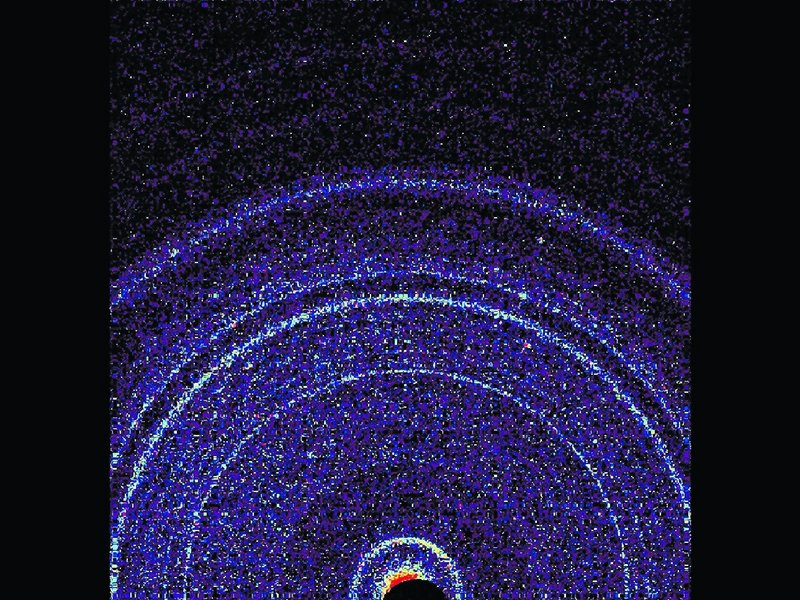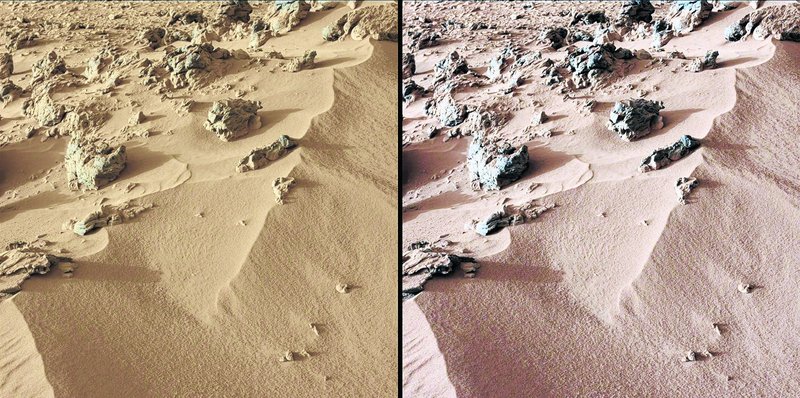NASA’s Mars rover Curiosity has found complex chemicals in the dusty soil of the Red Planet, including some evidence of organic compounds, one of the basic building blocks of life — but nothing that definitively shows there is or ever was life on the Red Planet, scientists said Monday.
The rover, which landed on Mars on Aug. 6, has detected water molecules, sulfur and chlorine-containing substances, NASA team members announced at a highly anticipated news conference at the annual meeting of the American Geophysical Union in San Francisco.
But the organic compounds may not have originated on Mars, and may instead come from contamination from NASA’s instruments. The chemicals were detected using the rover’s robotic arm, which scooped soils in the Gale Crater area, and several high-tech devices, including the SAM — or Sample Analysis of Mars — instrument, which analyzes gases that come from dirt and rocks when they are heated in an oven aboard the six-wheeled rover.
“The instrument SAM is working perfectly well and has made this detection of organic compounds, simple organic compounds” said Curiosity Project Scientist John Grotzinger of the California Institute of Technology in Pasadena. “We don’t know if they are indigenous to Mars yet. It’s going to take us some time to work through that. I know there’s a lot of interest in that, but Curiosity’s middle name is patience, and we all have to have a healthy dose of that.”
In November, the science world, media organizations and the Internet crackled with speculation after Grotzinger announced in an interview on NPR: “This data is going to be one for the history books. It’s looking really good” and then declined to go into detail. Observers wondered if the rover had detected life on Mars, fossils or some other groundbreaking find.
As the days passed, however, NASA began to dial back expectations, saying that Grotzinger was referring to the two-year mission as a whole, rather than one specific find. On Monday, Grotzinger said the episode has been a learning experience.
“The enthusiasm that we had, that I had, that our whole team had, I think was just misunderstood. There’s not much more to say than that,” he said, adding “The first thing I thought is ‘Gosh, I have to be careful about what I say.”‘
The two-year, $2.5 billion mission — successfully sending the largest craft ever from Earth to land on another planet — has renewed public interest in Mars. Over the past six weeks, the Martian rover has scooped five samples from an area called “Rock Nest,” a flat spot in Gale Crater.
“It’s finer than sugar but coarser than something like flour,” said Ken Edgett of Malin Space Science Systems in San Diego, who is a lead scientist working on the camera on the rover’s arm.
Curiosity also found perchlorate, a reactive salt, which had been detected by the earlier Phoenix Mars mission in 2008. When the perchlorate was heated in the rover’s oven, it created chlorinated methane compounds — one-carbon organics. NASA officials said Monday that the chlorine appears to be of Martian origin, but the carbon may have come from Earth, via the rover, or from another source, such as meteorites.
Last week, NASA detected organic compounds on the planet Mercury. If organic compounds of Martian origin are confirmed on the Red Planet over the months and years ahead, it is important because they could serve as an energy source for microbes that live — or once lived — on Mars.
Confirming the organic compounds, then seeing if they are related to biological material, will take time, said Grotzinger, referring to the methodical pace of science.
“There’s not going to be one single moment when we all stand up and, on the basis of a single measurement, have a Hallelujah moment,” he said. “We are going to take our time, and if we’ve found something significant, we’ll be happy to report that.”
Send questions/comments to the editors.




Success. Please wait for the page to reload. If the page does not reload within 5 seconds, please refresh the page.
Enter your email and password to access comments.
Hi, to comment on stories you must . This profile is in addition to your subscription and website login.
Already have a commenting profile? .
Invalid username/password.
Please check your email to confirm and complete your registration.
Only subscribers are eligible to post comments. Please subscribe or login first for digital access. Here’s why.
Use the form below to reset your password. When you've submitted your account email, we will send an email with a reset code.